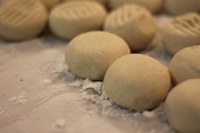The gluten protein in dough makes it strong.
(Click an image below to view a high-resolution image that can be downloaded)
By Julie Garden-Robinson, Food and Nutrition Specialist
NDSU Extension
“They’re staring at me,” I texted my husband.
I felt like a guppy in a small fishbowl.
I was at my desk on campus after hours preparing to do a live food demonstration on Zoom. My audience was a group of nearly 20 4-H’ers in their home kitchens.
Many arrived at the Zoom call early. I was setting up my desk area with my computer camera on, and I was wearing my headset and mic. I moved a small table near my desktop computer.
They were excited to get a closer look at what I was doing.
One girl had her eye right up to her camera. A blinking eyeball was all I saw in her participant screen. That was a bit disconcerting.
We were going to make homemade flour tortillas together. My ingredients, bowls, measuring cups, rolling pin and a griddle were arranged in front of me. I also had a bucket of warm water and some towels to clean my hands and desk. A sink in my office would be handy these days.
We are nearly at the first anniversary of the beginning of the COVID-19 pandemic. Like everyone else, I have had to figure out how to make a challenging situation work to the best of my ability.
We mixed the dough and then rolled it into small balls. Then we flattened the dough into circles with a rolling pin and cooked it on a griddle.
The kids had great fun punching and stretching their dough. As I watched them, this activity seemed like a metaphor for what we have gone through in the past year.
The strong dough was made possible by the gluten protein it contained. Gluten is found in grains such as wheat, rye and barley.
When we form dough, we create “gluten,” a protein-rich matrix made up of two components called glutenin and gliadin.
Glutenin provides the elastic properties to dough. It will spring back when it is kneaded. Glutenin’s elastic nature lends its strength to form a framework for bread products.
Gliadin provides the extensibility. When making bread, this stretchiness provides bread with the ability to rise.
I think we have needed some inner strength as well as flexibility to get through the past year.
“Gluten” is not well understood by many consumers. We see “gluten free” on many food products. We might think that gluten must be avoided by everyone. The vast majority of the population can consume gluten-containing foods without issues.
However, people with celiac disease need to avoid gluten. The gliadin component is the most problematic and it triggers an immune reaction in people with celiac issues.
An estimated 1% of the population has celiac disease, according to the Celiac Disease Foundation at https://celiac.org. This means that more than 3 million people in the U.S. must avoid gluten in foods. They also need to avoid other gluten-containing items they might swallow, such as gluten-containing toothpaste, mouthwash or glue on some envelopes.
People who are female, Caucasian and of European descent appear to have a greater risk of celiac disease. Those with celiac disease might experience one or more of 300 different symptoms, including abdominal pain, bloating, diarrhea, damage to their intestines and skin rashes. Unless treated, celiac disease can have many long-term health consequences.
People who are gluten-sensitive have similar symptoms but usually do not have the damage to their intestines. Remember that issues with gluten should be diagnosed with the help of qualified professionals, not on your own. The Celiac Foundation has resources to help.
I don’t think any of my young tortilla makers had issues with gluten. They munched happily on their tortilla creations within an hour of us starting with the ingredients.
They were able to list many potential toppings for tortillas, including taco meat and cheese, or peanut butter and bananas. I was thinking a warm tortilla spread with a little butter and sprinkled with cinnamon and sugar would be a tasty dessert.
You might enjoy making homemade tortillas. Think about your inner strength and flexibility as you manipulate the dough.
Homemade Flour Tortillas
1 1/2 c. all-purpose flour (or use half whole wheat)
1/2 tsp. salt
1/2 tsp. baking powder
1/2 c. hot water (about 110 F)
2 Tbsp. cooking oil
Mix flour, salt and baking powder in a mixing bowl. Add hot water and oil. Knead the dough with your hands in the bowl until a smooth dough is formed. Form the dough into a disk in the bowl. Cover with a damp paper towel or kitchen towel. Allow to rest for 10 minutes. Cut the dough into six even wedges. Roll the dough into balls. Lay a piece of waxed paper on the counter, spray with cooking spray and place one dough ball in the center. Cover the dough ball with a second piece of waxed paper. Use a rolling pin or a soup can to roll the piece of dough into a circle about 4 or 5 inches across. If your dough is too sticky, add more flour to the rest of the dough balls. Heat a nonstick skillet on medium heat. Peel the tortilla away from the waxed paper and cook for about one to two minutes. Flip with a turner and cook the other side for about one to two minutes. The time will vary depending on how hot the pan or griddle is. Repeat.
Makes six tortillas. Each tortilla has 140 calories, 5 grams (g) fat, 3 g protein, 22 g carbohydrate, 1 g fiber and 250 milligrams sodium.
(Julie Garden-Robinson, Ph.D., R.D., L.R.D., is a North Dakota State University Extension food and nutrition specialist and professor in the Department of Health, Nutrition and Exercise Sciences. Follow her on Twitter @jgardenrobinson)
NDSU Agriculture Communication - Feb. 11, 2021
Source: Julie Garden-Robinson, 701-231-7187, julie.garden-robinson@ndsu.edu
Editor: Ellen Crawford, 701-231-5391, ellen.crawford@ndsu.edu




